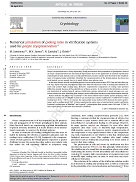Por favor, use este identificador para citar o enlazar este ítem:
https://repositorio.uca.edu.ar/handle/123456789/5467| Título: | Numerical simulation of cooling rates in vitrification systems used for oocyte cryopreservation | Autor: | Sansiñena, Marina Julia Santos, María Victoria Zaritzky, Noemí Chirife, Jorge |
Otros colaboradores: | Universidad Católica Argentina. Facultad de Ciencias Agrarias Universidad Nacional de La Plata. Facultad de Ingeniería. Centro de Investigación y Desarrollo en Criotecnología de Alimentos |
Palabras clave: | ENFRIAMIENTO; OVOCITOS; TRANSFERENCIA DE CALOR; METODO DE ELEMENTOS FINITOS | Fecha de publicación: | 2011 | Cita: | Sansiñena, M., Santos, M.V., Zaritzky, N. y J. Chirife. 2011. Numerical simulation of cooling rates in vitrification systems used for oocyte cryopreservation [en línea]. Postprint del artículo publiccado en Cryobiology 63. Disponible en: https://repositorio.uca.edu.ar/handle/123456789/5467 | Resumen: | Abstract: Oocyte cryopreservation is of key importance in the preservation and propagation of germplasm. Interest 24 in oocyte cryopreservation has increased in recent years due to the application of assisted reproductive 25 technologies in farm animals such as in vitro fertilization, nuclear transfer and the need for the establish- 26 ment of ova/gene banks worldwide. However, the cryopreservation of the female gamete has been met 27 with limited success mainly due to its small surface-area:volume ratio. 28 In the past decade, several vitrification devices such as open pulled straws (OPS), fine and ultra fine pip- 29 ette tips, nylon loops and polyethylene films have been introduced in order to manipulate minimal vol- 30 umes and achieve high cooling rates. However, experimental comparison of cooling rates presents 31 difficulties mainly because of the reduced size of these systems. To circumvent this limitation, a numer- 32 ical simulation of cooling rates of various vitrification systems immersed in liquid nitrogen was con- 33 ducted solving the non-stationary heat transfer partial differential equation using finite element method. 34 Results indicate the nylon loop (Cryoloop) is the most efficient heat transfer system analyzed, with a 35 predicted cooling rate of 180,000 C/min for an external heat transfer coefficient h = 1000W/m2 K when 36 cooling from 20 to 130 C; in contrast, the open pulled straw method (OPS) showed the lowest perfor- 37 mance with a cooling rate of 5521 C/min considering the same value of external heat transfer coefficient. 38 Predicted cooling rates of Miniflex and Cryotop (polyethylene film system) were 6164 and 37,500 C/ 39 min, respectively, for the same heat transfer coefficient | URI: | https://repositorio.uca.edu.ar/handle/123456789/5467 | Disciplina: | PRODUCCION AGROPECUARIA | Derechos: | Acceso Abierto | Fuente: | Posprint del documento publicado en Cryobiology 63, 2011 |
| Aparece en las colecciones: | Artículos |
Ficheros en este ítem:
| Fichero | Descripción | Tamaño | Formato | |
|---|---|---|---|---|
| numerical-simulation-cooling-rates.pdf | 1,01 MB | Adobe PDF |  Visualizar/Abrir |
Visualizaciones de página(s)
122
comprobado en 30-abr-2024
Descarga(s)
308
comprobado en 30-abr-2024
Google ScholarTM
Ver en Google Scholar
Este ítem está sujeto a una Licencia Creative Commons

